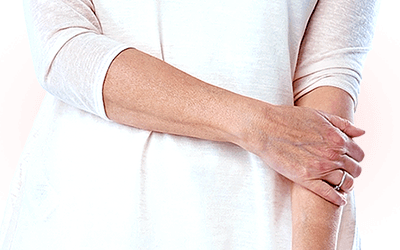While women at various stages of life might be familiar with occasional and short-lived tingling extremities, when it is accompanied with pain, it is undoubtedly a cause for concern. As such, knowing when to seek help is key to finding adequate treatment and restoring a pain-free life.
Read on to learn all about pain and tingling in the legs, feet, or hands, including what it is, what causes it, and how to manage it as you put a step toward finding ultimate reprieve for years to come.
About Tingling Pain in Feet, Legs, and Hands
While the sensation of tingling - such as when a foot falls asleep and then receives an influx of blood flow - is often uncomfortable, it is rarely directly painful. It is commonly caused by hormonal imbalance or improper posture.
Painful tingling in the limbs, however, is most commonly due to peripheral neuropathy, a term that describes damage to the nerves that can cause them to malfunction and affect the signaling between the brain, spinal cord, and limbs.
Besides pain or burning sensation, women with peripheral neuropathy may also experience numbness, muscle weakness, and increased sensitivity to touch, among other symtpoms.1
Causes of Pain and Tingling in Feet, Legs, and Hands
Peripheral neuropathy can affect sensory nerves in the feet and legs as well as hands and arms, although it is also possible to affect motor and autonomic nerves influencing other body functions. It is often caused by the following conditions:
Diabetes
Diabetes neuropathy, mostly experienced in the feet, is estimated to affect up to 70% of people with diabetes.2 It is most commonly characterized by numbness and painful tingling in the feet.
Infections
Caused by various microorganisms, infections can spread to affect peripheral nerves and bring up symptoms such as painful tingling in the feet, legs, arms, and hands. They include Lyme disease, shingles, or Epstein-Barr virus.
Hormonal Imbalance
Peripheral nerves can also be compressed and eventually damaged due to swelling of tissues as a result of various hormonal imbalance-triggered disruptions in bodily processes.
Nerve Injury
Various injuries can cause damage or exert damaging pressure on the nerves, leading to painful tingling in the limbs. Wearing a cast for a long period of time can also bring about similar discomforts.
Vitamin B12 Deficiency
While vitamin B12 deficiency is the most common type of nutritional deficiency associated with pain and numbness in hands, lacks in other vitamins, like E and B1, can also contribute to the symptom.
Autoimmune Diseases
A number of autoimmune conditions, like lupus, rheumatoid arthritis, or Guillain-Barre syndrome, can lead to damage to the nerves and manifest as painful tingling in the extremities.
Lifestyle Practices
Excessive consumption of alcohol, prolonged stress, and a sedentary lifestyle can all contribute to the development of peripheral neuropathy and, in turn, pain and tingling in the hands, feet, and legs.
Management of Pain and Tingling in Legs, Feet, and Hands
The way to manage painful tingling depends on its cause as well as severity. While mild pain can be tackled with lifestyle adjustments and alternative medicine, more severe pain might have to be managed with medications or surgery.
Proper nutrition. Ensuring healthy levels of essential nutrients through diet, particularly vitamin B12, can help relieve painful tingling in the feet, hands, and legs naturally. For some deficiencies, supplements might also be necessary.
Regular exercise. Physical activity that focuses on strengthening the musculature, improving balance, and boosting circulation is a valuable addition to managing painful tingling in the extremities.
Herbal supplements. When rooted in hormonal imbalance, painful tingling during menopause can be relieved with phytoestrogenic supplements, like red clover, or hormone-regulating supplements, like Macafem.
Physical therapy. It can improve strength, balance, function, and range of motion in people suffering from hand, feet, and leg pain and tingling.
Acupuncture. Although research continues to study the effects of acupuncture on nerve pain, some women significantly benefit from it, often enough to cut down on pain-relieving medications.3
Medications. Ranging from over-the-counter oral and topical pain relievers to prescription medications, pharmaceutical options for peripheral neuropathic pain are abundant, but typically come with side effects.
Transcutaneous Electronic Nerve Stimulation (TENS). Some forms of nerve pain, particularly of diabetic origin, can be reduced with TENS, which works by stopping the pain signals from reaching the brain.4
Conclusions
Without a doubt, dealing with pain and tingling in the legs, feet, and hands is not easy, especially when it affects a woman's daily activities. Once the root cause has been identified, she is encouraged to approach finding effective management approaches with patience and faith that a symptom-free life is within her reach. Meanwhile, it is worth learning how to tell the difference between an innocent tingling in left arm and warning signs of a heart attack or stroke so that no symptoms are ever overlooked, and help is received fast for ultimate health and well-being.
Sources
- Health Direct. (2019). Peripheral neuropathy. Retrieved November 4, 2019 from https://www.healthdirect.gov.au/peripheral-neuropathy
- Mayo Clinic. (2016). Numbness in hands. Retrieved November 4, 2019 from http://www.mayoclinic.org/symptoms/numbness-in-hands/basics/definition/sym-20050842
- Mayo Clinic. (2019). Peripheral neuropathy. Retrieved November 4, 2019 from https://www.mayoclinic.org/diseases-conditions/peripheral-neuropathy/symptoms-causes/syc-20352061
- Medline Plus. (2015). Numbness and tingling. Retrieved November 4, 2019 from https://medlineplus.gov/ency/article/003206.htm
- Medline Plus. (2019). Peripheral neuropathy. Retrieved November 4, 2019 from https://medlineplus.gov/ency/article/000593.htm
- nidirect. (2019). Pins and needles. Retrieved November 4, 2019 from https://www.nidirect.gov.uk/conditions/pins-and-needles
- The Foundation for Peripheral Neuropathy. (n.d.). Maintaining a Healthy Lifestyle. Retrieved November 4, 2019 from https://www.foundationforpn.org/living-well/lifestyle/
- The Foundation for Peripheral Neuropathy. (n.d.). Peripheral Neuropathy Treatments. Retrieved November 4, 2019 from https://www.foundationforpn.org/living-well/lifestyle/
Footnotes:
- The Foundation for Peripheral Neuropathy. (n.d.). What is Peripheral Neuropathy? Retrieved November 4, 2019 from https://www.foundationforpn.org/what-is-peripheral-neuropathy/
- National Institute of Diabetes and Digestive and Kidney Diseases. (2018). Peripheral Neuropathy. Retrieved November 4, 2019 from https://www.niddk.nih.gov/health-information/diabetes/overview/preventing-problems/nerve-damage-diabetic-neuropathies/peripheral-neuropathy
- Journal of Alternative and Complementary Medicine. (2017). Acupuncture for the Treatment of Peripheral neuropathy: A Systematic review and meta-analysis. Retrieved November 4, 2019 from https://www.ncbi.nlm.nih.gov/pmc/articles/PMC5359694/
- National Institute of Neurological Disorders and Stroke. (2019). Peripheral Neuropathy Fact Sheet. Retrieved November 4, 2019 from https://www.ninds.nih.gov/Disorders/Patient-Caregiver-Education/Fact-Sheets/Peripheral-Neuropathy-Fact-Sheet


